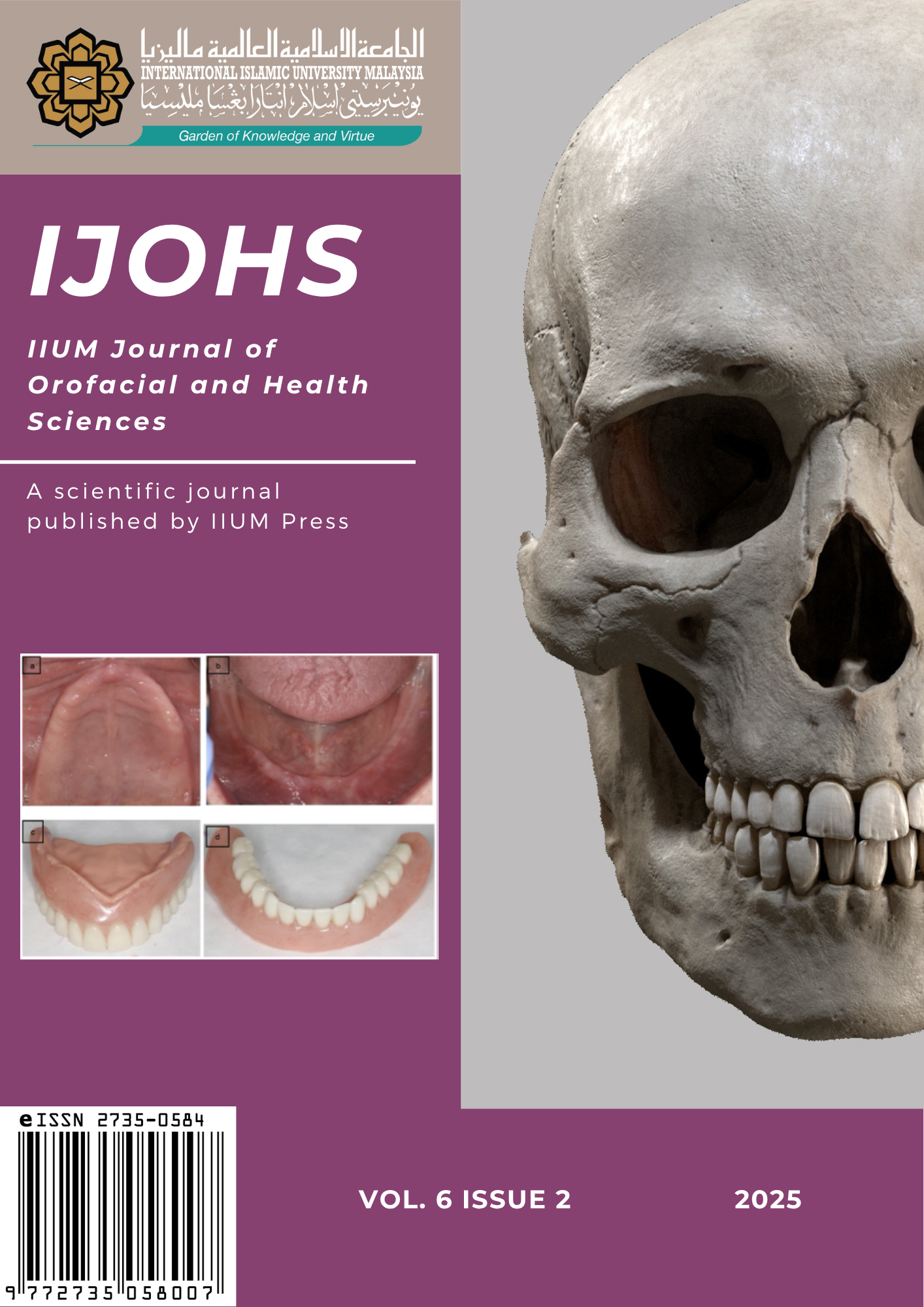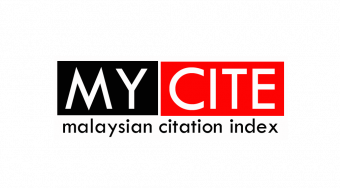Root canal treatment of a maxillary left first molar with 2 palatal canals - a case report
DOI:
https://doi.org/10.31436/ijohs.v6i2.312Keywords:
aberrant root canal, CBCT aided, endodontic management, maxillary molarAbstract
Comprehensive knowledge of normal dental anatomy and awareness of potential anatomical variations are crucial to successful endodontic treatment. Anatomical variations such as additional canals in the palatal root of the maxillary molar are poorly reported, attributed to their low prevalence in general populations. This case report highlights the utilization of cone beam computed tomography (CBCT) as a diagnostic tool for locating additional canal in the palatal root of maxillary left first molar. The application of CBCT imaging technology in endodontics enables precise diagnosis through enhanced visualization of anatomical variations, thereby enhancing treatment planning and management of cases presenting with complex canal morphology. The present case documents the successful management of a maxillary left first molar exhibiting abnormal morphology of four canals: two located in the palatal root, one in the mesiobuccal root, and one in the distobuccal root. The canals were biomechanically prepared with crown-down technique and obturated using cold lateral compaction technique with gutta-percha points and AH-Plus root canal sealer. Post-treatment evaluation at six months demonstrated clinical success, with the tooth remaining asymptomatic and maintaining its normal function.
References
AAE and AAOMR Joint Position Statement (2015). Use of cone beam computed tomography in endodontics 2015 update. Journal of Endodontics, 41,1393-1396.
Al-Qudah, A., Afaneh, A., Hassouneh, L. (2023). A case report of a maxillary second molar with two distinct palatal canals, confirmed by CBCT. Clinical Cosmetic and Investigational Dentistry, 15,199-203
Asghari, V., Rahimi, S., Ghasemi, N., Talebzadeh, B., Norlouoni, A. (2015). Treatment of a maxillary first molar with two palatal roots. Iran Endodontic Journal, 10(4), 287-289.
Azim, A.A., Griggs, J.A., Huang, G.T. (2016). The Tennessee study: factors affecting treatment outcome and healing time following nonsurgical root canal treatment. International Endodontic Journal, 49, 6-16.
Azim, A.A., Deutsch, A.S., Solomon, C.S. (2015). Prevalence of middle mesial canals in mandibular molars after guided troughing under high magnification: an in vivo investigation. Journal of Endodontics, 41, 164-168.
Camacho-Aparicio, L.A., Borges-Yáñez, S.A., Estrada, D., Azcárraga, M., Jiménez, R., González-Plata-R, R. (2022). Validity of the dental operating microscope and selective dentin removal with ultrasonic tips for locating the second mesiobuccal canal (MB2) in maxillary first molars: an in vivo study. Journal of Clinical and Experimental Dentistry,14, e471–e478.
Farzaneh, M., Abitbol, S., Lawrence, H.P., Friedman, S. (2004). Toronto Study. Treatment outcome in endodontics-the Toronto Study. Phase II: initial treatment. Journal of Endodontics, 30(5), 302-309.
Fransson, H., Dawson, V.S., Frisk, F., Bjørndal, L., EndoReCo, Kvist, T. (2016). Survival of root-filled teeth in the Swedish adult population. Journal of Endodontics, 42, 216-220.
Holderrieth, S., Gernhardt, C.R. (2009). Maxillary molars with morphologic variations of the palatal root canals: a report of four cases. Journal of Endodontics, 35 (7), 1060-1065.
Hull, T.E., Robertson, P.B., Steiner, J.C., del Aguila, M.A. (2003). Patterns of endodontic care for a Washington state population. Journal of Endodontics, 29, 553-556.
Nair P.N. (2006). On the causes of persistent apical periodontitis: a review. International Endodontic Journal, 2006, 39, 249-281.
Neelakantan, P., Subbarao, C., Ahuja, R., Subbarao, C.V., Gutmann, J.L. (2010). Cone-beam computed tomography study of root and canal morphology of maxillary first and second molars in an Indian population. Journal of Endodontics, 36, 1622-1627.
Ng, Y.L., Mann, V., Rahbaran, S., Lewsey, J., Gulabivala, K., (2008). Outcome of primary root canal treatment: systematic review of the literature–part 2. Influence of clinical factors. International Endodontic Journal, 41, 6-31.
Nosrat, A., Deschenes, R.J., Tordik, P.A., Hicks, M.L., Fouad, A.F. (2015). Middle mesial canals in mandibular molars: incidence and related factors. Journal of Endodontics, 41, 28-32.
Lin, L.M., Pascon, E.A., Skribner J., Gängler P., Langeland K. (1991) Clinical, radiographic, and histologic study of endodontic treatment failures. Oral Surgery, Oral Medicine, Oral Pathology. 71, 603-611.
Low, J.F., Dom, T.N.M., Baharin, S.A. (2018) Magnification in endodontics: a review of its application and acceptance among dental practitioners. European Journal of Dentistry, 12, 610-616.
Shalavi, S., Mohammadi, Z., Abdolrazzaghi, M. (2012) Root canal treatment of maxillary and mandibular three-rooted premolars: case reports. Iran Endodontic Journal, 7, 161-164.
Singh, S., Pawar, M. (2015). Root canal morphology of South Asian Indian maxillary molar teeth. European Journal of Dentistry, 9, 133-144.
Siqueira, J.F. (2001) Aetiology of root canal treatment failure: why well?treated teeth can fail. International Endodontic Journal, 34, 1-10.
Stone, L.H., Stroner, W.F. (1981). Maxillary molars demonstrating more than one palatal root canal. Oral Surgery Oral Medicine Oral Pathology, 51, 649-652.
Song M., Kim H. C., Lee W., and Kim E. (2011). Analysis of the cause of failure in nonsurgical endodontic treatment by microscopic inspection during endodontic microsurgery, Journal of Endodontics. 37 (11), 1516–1519.
Sung, K.H., Hwang, H.K., Jo, H.H. (2021). Maxillary First Molars with Two Palatal Root Canals. Case Reports in Dentistry, 2021(1), 8885923.
Vizzotto, M.B., Silveira, P.F., Arus, N.A., Montagner, F., Gomes, B.P., da Silveira, H.E. (2013). CBCT for the assessment of second mesiobuccal (MB2) canals in maxillary molar teeth: effect of voxel size and presence of root filling. International Endodontic Journal, 46, 870-876.
Wasti, F., Shearer, A.C., Wilson, N.H. (2001). Root canal systems of the mandibular and maxillary first permanent molar teeth of south Asian Pakistanis. International Endodontic Journal, 34, 263-266.
Weng, X.L., Yu, S.B., Zhao, S.L., Wang, H.G., Mu, T., Tang, R.Y., et al. (2009). Root canal morphology of permanent maxillary teeth in the Han nationality in the Chinese Guanzhong area: a new modified root canal staining technique. Journal of Endodontics, 35, 651-656.
Wilcox, L.R., Walton, R.E., Case, W.B. (1989). Molar access: shape and outline according to orifice locations. Journal of Endodontics, 15, 315-318.
Zhuk, R., Taylor, S., Johnson, J.D., Paranjpe A. (2020). Locating the MB2 canal in relation to MB1 in maxillary first molars using CBCT imaging. Australian Endodontic Journal. 46, 184–190.












